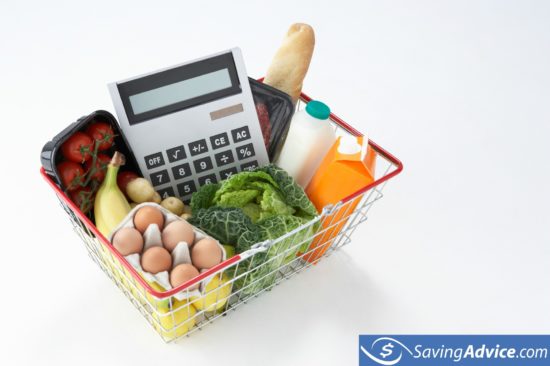
Well, if your food expenses seem out of control – how often you shop may have something to do with it.
What is the Average Grocery Budget?
Depending on the size of your family, the average grocery budget can go anywhere from $197 per month to over $2,800 a month. According to Growing Slower, a liberal grocery budget for one person could cost as much as $442 a month. Families of four are projected to spend between $550 and $1,400 each month on groceries.
When You Shop Impacts Your Grocery Budget
If you’re like many people, the idea of spending hundreds of dollars on something that doesn’t really provide anything besides nourishment seems crazy. What you may not know is that the time of day, time of the month and how often you head to the store can seriously impact your grocery budget.
The more frequent your trips to the store are, the higher your monthly grocery budget is likely to be. A portion of this is because you’ll be taxed every time you go to buy a small item (if you live in a state which taxes food). The larger reason why frequent trips to the grocery store may end up increasing your grocery budget is that there is little-to-no planning if you go to the grocery store every day. This makes it so that you’re not able to buy in bulk to make multiple meals and you’ll likely spend more cash on individual items.
You may also be able to lower your grocery budget by choosing to shop at a different time of day. Many grocers mark down meats at the end of the day, for example. If you want to purchase something from the meat department you may want to wait until after 6 p.m. Similarly, if the store is open 24 hours you may be able to score some deals early in the morning. You should also keep an eye on your local store’s deals. Most grocers release new sales and discounts on Wednesday, which makes it a great day to head to the grocery store.
Great Places to Get Good Deals on Groceries
No matter how often you decide to go to the grocery store, there are a few stores you can head to to try and trim your grocery budget down a bit.
Aldi
For many people, that store is Aldi. The retailer has refined its processes to be able to provide its customers with great pricing. The company claims to save customers 40% of their regular grocery bill. So, if you normally spend $100 a week on groceries you’ll only spend about $60 at Aldi. There are some downfalls though. The company doesn’t provide grocery bags, accept coupons or carry many name brand items. Aldi also doesn’t carry everything so there’s a chance you may still have to head to your regular grocer. All in all, though, Aldi is worth a try!
Costco
If you’re looking to trim your grocery budget by making fewer trips to the store, Costco may be the best place for you to go. Costco is known for selling products in bulk to help its customers save more. Like Aldi, it has taken a simple, warehouse-style approach but Costco has much more than just groceries to offer. The company offers great deals on electronics, automotive care, alcohol and many other products as well. Costco also accepts most forms of payment. You can visit Costco as a guest to see if the annual membership fee of $60 or you can use a Costco cash card to shop there without a membership.
Other Great Ways to Save on Groceries

- Plan. Plan. Plan. Meal planning is a key component of having a sound grocery budget. If you’re able to plan your meals out for the week, or even the month, you’ll be able to buy bulk items that will be shared across meals. For instance, if you buy ground beef you can plan to use it for spaghetti, meatloaf and tacos (paying about $10 for three meals-worth of meat).
- Substitute name brands. The generic brands taste about the same and cost way less. Switching from name brand products can save you quite a bit of money. Most people found that by going with the cheaper, generic product they saved up to 25% on their grocery budget.
- Start using coupons. You may have heard of extreme couponing before. Some shoppers have been able to get paid after checking out (yes, the grocer owed THEM money!). Even if you don’t want to go to extremes, every penny saved helps.
- Use self-checkout. It has been proven that shoppers save anywhere from 17% to 32% on their grocery budget by checking themselves out. This is because swiping the items yourself decreases the number of impulse purchases you make.
- Rewards programs. Many stores have rewards programs, which can save you additional cash, and provide exclusive discounts based on the items you purchase frequently. This can prove to save you quite a bit of money over time.
- Use apps. You can continue to save money even after you’ve checked out. In addition to your rewards program, you can also check into apps like Checkout51 and the Walmart Savings Catcher app to get your price-match guarantees and other discounts refunded to you after you’ve gotten home.
If you want help around your unique grocery situation, consider visiting the Saving Advice forums. The community there is very helpful.
Give the gift of savings! Learn more
For more articles on this topic consider the following:
Do you have any grocery budget tips? Share them with us!
Photo: Kauai Shopping and NDSU

James Hendrickson is an internet entrepreneur, blogging junky, hunter and personal finance geek. When he’s not lurking in coffee shops in Portland, Oregon, you’ll find him in the Pacific Northwest’s great outdoors. James has a masters degree in Sociology from the University of Maryland at College Park and a Bachelors degree on Sociology from Earlham College. He loves individual stocks, bonds and precious metals.
Comments